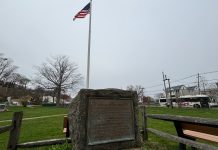By Rick Geffken |
OCEANPORT – Ask New Jerseyans about Oceanport and most will mention Monmouth Racetrack or Fort Monmouth. Fair enough, since these well-known spots have important legacies in the 3-square-mile borough. But ask how the town on the South Shrewsbury River got its name and even many of its 6,000 residents might give you a quizzical look.
Thanks to Oceanport resident Frank Barricelli we’ll all be able to read about the town’s substantial maritime history. Busy researching the town he’s loved since he began working as an engineer at Fort Monmouth in 1966, Barricelli is documenting and writing about Oceanport’s historic connection to the Atlantic Ocean. He’s aiming to finish a book in time for the 2020 centennial celebration of the borough’s incorporation.
The Borough of Oceanport was formed in April 1920, cleaving itself off from Eatontown Township. Two hundred fifty years earlier, the widow of one of the 12 Monmouth Patentees, Sarah Reape, settled at Pumpkin Point. She was the first known European settler on the neck of land called Port-au-Peck. Barricelli himself lives on part of her former property called Sands Point these days.
“The town’s founding actually centered on today’s Wharf Park area,” says Barricelli. Early on, charcoal and lumber were stored dockside before shipment to New York City through the Shrewsbury Inlet. The inlet was opposite Black Point (Rumson) when Sandy Hook was still an island. “Known as the Eaton Town Dock, our town began as a seaport for much of this part of Monmouth County,” continues Barricelli. “James P. Allaire built a wharf and warehouse here in the 1830s.”
Wagons from Allaire’s Iron Works in Howell transported all kinds of manufactured ironware like pots and teakettles to the steamship dock. Though the Manasquan Inlet was closer to his furnace and factories, Allaire chose to build at the Eaton Town Dock. County historian Randall Gabrielan explained why this was most likely: “The Manasquan River was probably a muddy stream in a sparsely settled region then and, of course, one could not build a dock on the ocean,” he said. “In addition, the open ocean voyage from there would have been that much longer (than from the Shrewsbury Inlet).”
Barricelli emphasizes that he is only one member of a newly formed historical committee working on the book project, albeit the primary researcher. “The idea for a new book actually came from the late Mayor Maria Gatta quite a while ago. She gave me a copy of the 1970 “Oceanport in Retrospect” and asked me to update it. When she passed away shortly after – I looked at her almost like a sister – I lost interest in the project, until two years ago.” His enthusiasm was reignited when he joined the Environmental Restoration Advisory Board for Fort Monmouth after he had retired.
Barricelli goes on to describe how the town’s fortunes declined in the 19thcentury primarily due to two impactful events. Though storms had closed and reopened the Shrewsbury Inlet many times, it sanded over for good around 1845. Ships were forced to take the longer inside route up the Shrewsbury River and around Sandy Hook to get to New York. When the railroad pushed its way through the “Ocean Port” in 1861, the wharf business could no longer compete economically.
Oceanport experienced a business revival when two large entities arrived. Monmouth Park Racetrack opened in 1870, relocated west of the current track in 1890 and finally settled at its current location in 1946. It’s now owned by the New Jersey Sports and Exposition Authority.
The second boon to Oceanport occurred during World War I. Originally called Camp Alfred Vail, Fort Monmouth was renamed in 1925 and evolved into the U.S. Army Signal Corps Headquarters. About 30 percent of the now decommissioned base is in Oceanport. The rest is in parts of Eatontown and Tinton Falls.
Oceanport’s Mayor John “Jay” Coffey sees both the racetrack and the former Army base as vital to the town’s future. “Just a few years ago we were concerned with the viability of Monmouth Park Racetrack, Oceanport’s largest employer and our largest tax ratable. Now, with legalized sports wagering in New Jersey, the better the track does, the better it is for Oceanport,” said Coffey.
Coffey enthuses about a recent visit to Monmouth Park. “On Father’s Day my wife and I stopped by the track for a few races. We heard all kinds of music all over the park. The great smell of hamburgers, hot dogs and horse poop permeated the air. I was told upwards of 25,000 people were there. The vibe and electricity of life at the track is back!”
As for Fort Monmouth, Coffey is proud that Oceanport paid $1 million for 13 acres of Fort Monmouth property and will soon relocate its Oceanport Municipal Complex there. “We won’t have to put up anything new. We’ll be rehabbing existing space – a courthouse, community center, DPW, Town Hall, a library, even a jail. We’ll have it all done by September 2019.Oceanport is trending upwards.”
This article first appeared in the July 12 – 19, 2018 print edition of The Two River Times.














